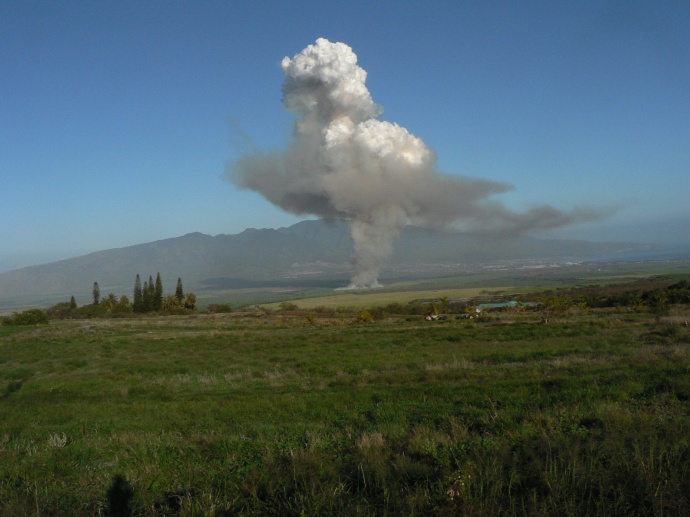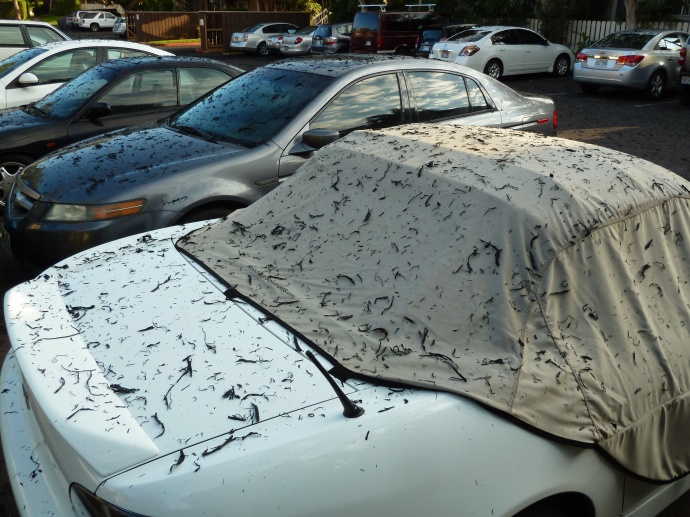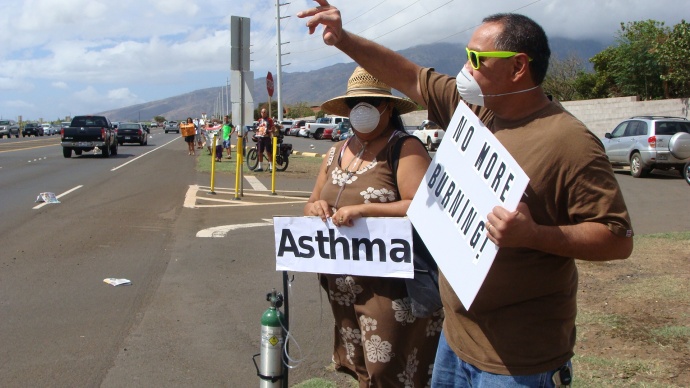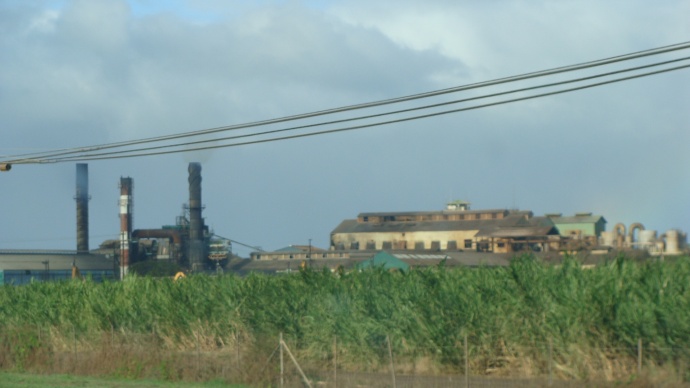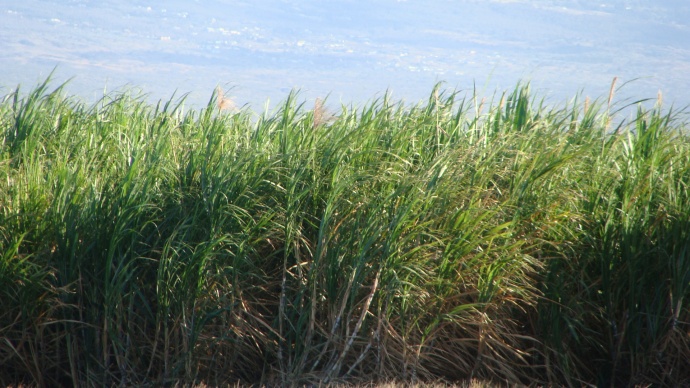Stop Cane Burning Files Legal Action to Invalidate HC&S Burn Permit
By Wendy Osher
The Maui group Stop Cane Burning filed a lawsuit on Wednesday against the state Department of Health, seeking an injunction to immediately stop agricultural burning on Maui and effectively invalidate the burn permit issued to Hawaiian Commercial and Sugar Company.
The lawsuit is the first to be filed on Maui in the new Environmental Court, and alleges that the regulatory system which allows the open air burning is unconstitutional.
The group Stop Cane Burning was founded by Maui resident Karen Chun in 2011, and is working to end what group leaders call an “archaic and damaging practice.”
In a press release issued on Thursday, the group said the smoke often drops on schools, homes, businesses and roads, and alleges that it is causing “acute breathing problems and long term health damage.” The group further states that, “As the trades have decreased and population downwind has increased, the smoke is affecting the health of more and more people.”
Chun is joined by other plaintiffs, Trinette Furtado of Maui and Brad Edwards of Oʻahu in filing the lawsuit. Furtado has expressed concerns about the health and well being of her 10-year-old daughter who attends Ke Kula Kaiapuni o Pā’ia, a school surrounded by cane fields and “inundated by cane smoke on burn days,” according to her claims. She is adamant that “the sugarcane industry is not ‘a Hawaiian institution’,” saying, “It was not kānaka who industrialized it.”
HC&S general manager Rick Volner responded to our request for comment on the filing saying, “We cannot comment on the lawsuit itself, as we have not yet had a chance to give it a thorough review; However, what we can say is that the practice of agricultural burning, as a harvesting method, is not unique to Hawaiʻi or HC&S.”
According to Volner, agricultural burning is practiced throughout the world in most areas where sugarcane is grown, including each of the other US sugarcane producing states of Florida, Louisiana and Texas, as well as Brazil, Australia, India, China, Mexico and 90 other countries.
He continued saying, “There are significant rules and procedures that HC&S follows when it does an agricultural burn. These are rules issued pursuant to the Clean Air Act and state air pollution control regulations, and are administered by the State Department of Health.”
According to the Stop Cane Burning group, the lawsuit asserts five separate counts and makes the following claims:
- (1) The state Air Pollution Control Act lacks any standards upon which the DoH may lawfully adopt rules and the rules that have been adopted constitute an unlawful delegation of legislative power in violation of Article III, Section 1 of the State Constitution.
- (2) Permitting of agricultural burning violates Article XI, Section 9 of the State Constitution’s right to a clean and healthful environment.
- (3) Permitting of agricultural burning constitutes a breach of the public trust protected under Article XI, Section 1 of the State Constitution.
- (4) Exempting agricultural burning from the general ban on open air burning is an irrational classification in violation of the equal protection clause of Article I, Section 5 of the State Constitution.
- (5) The Department of Health failed to consider the Hawaiʻi Environmental Policy Act (HRS Ch. 344) when it promulgated the rules for permitting of open air agricultural burning and are invalid.
The Stop Cane Burning Group states that in 1971, the DoH gave sugar plantations three years to end cane burning, a claim which HC&S officials dispute.
According to the Stop Cane Burning Group, “Then head of the Air Sanitation Branch (now called Clean Air Branch) Robert S. Nekomoto cited a 1967 study which found a high incidence of asthma among people who breathed cane smoke.”
Contrary to the groups claims, Volner contends that while a ban was proposed by the DOH in 1971, no law or regulation enacting such a ban was ever adopted. “Instead, the legislature requested a study of the issue by the DOH, Department of Agriculture, and Office of Environmental Quality Control, ” said Volner. He continued saying that study concluded, “no significant data are available which show either a hazardous or beneficial relationship of sugarcane burning to respiratory diseases.”
Volner said, “Further studies demonstrated that sugarcane burning, even at a time when 18 sugar plantations were still operating in the state, would not prevent compliance with newly adopted ambient air quality standards. On this basis, in July 1973 DOH concluded that the proposed ban on agricultural burning was not necessary, and instead implemented its first permit program for regulating agricultural burning.”
The group Stop Cane Burning states that in 1973 backyard burning was banned on O’ahu and DoH banned it on all islands in 2012 saying “Open burning creates an unnecessary nuisance and possible health risk due to the smoke and air pollution it produces.”
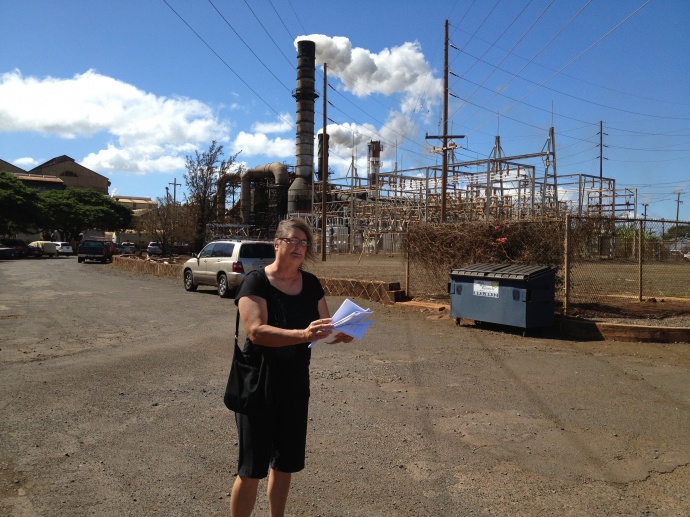
Maui resident Karen Chun started the Stop Cane Burning group in 2011. She is pictured here in front of the HC&S Puʻunēnē Mill in Central Maui. File photo courtesy Jackie Peterson.
“Does it make sense that backyard burning is banned as a health risk but HC&S is allowed to burn 36,000 acres six days a week, nine months per year?” Chun asked.
Chun said she believed HC&S when they said their smoke was harmless until she got Reactive Airway Disease, claiming it was from a bad burn in 2011. “She vowed she’d do everything possible to prevent smoke from ruining anyone else’s health and founded Stop Cane Burning that same year,” the group said in an announcement.
Chun’s children are descendants of cane workers who came from Japan in the early 1990s. She has a MS degree in engineering and is an avid outrigger canoe paddler and state medalist. “Although lung disease has damaged her competitiveness in the last four years,” Chun said she still paddles as much as she is able.
Volner states that over the years, HC&S has been making changes to its burning practices in an effort to minimize the effects of cane burning.
“Whereas in 1971 no program for regulating agricultural burning even existed, our current permit is a nearly 100-page document of specific protocols, field by field, that must be followed before a burn is made. Compliance with all conditions of our permit is a top priority for HC&S, and we are working with the DOH to find additional ways to better predict smoke patterns from a burn. HC&S has been practicing cane burning for over 140 years, and today conducts approximately150 burns per year. There are a few incidents when wind conditions do not turn out as predicted, or change, and we have a burn that impacts the residents in the area, and for that we are very apologetic,” said Volner.

Kids covering their mouths as they walk to class, May 26-27, 2015. Courtesy photo: Stop Cane Burning/Truth about Maui.
Plaintiff Brad Edwards disagrees saying, “HC&S has been dragging their feet and promising the end of cane burning is just around the corner for 44 years,” and added, “We don’t believe them any more.”
Edwards, who has a degree in Environmental Science and Social Work, has been working with at-risk children and families for almost 15 years. In his work with children and families on Maui, Edwards says he has become “all too familiar with many of the challenges and struggles that families on Maui face and sees firsthand the negative health effects” that children, including his hānai son, face when they “have no choice but to breathe in smoke from local cane fires.”
“I’ve heard the countless promises made by HC&S over the past 30 years to find alternative harvesting methods and crops, only to be disappointed year after year by their lack of effort to implement necessary changes,” said Edwards.
In an organization press release, Edwards states that he values the employment opportunities that sustainable farming offers here on Maui and “looks forward to a time when all of Maui can benefit from clean, healthy, and sustainable farming jobs that keep our air clean and our island green.”
Volner contends that HC&S understands that there are those in our growing community with concerns about the impacts of its sugar operation, and says the company has tried to respond.
“HC&S strives each and every day to farm in a manner that minimizes the impacts to the community. Farming, by its very nature, can produce dust, noise, odors, and smoke which can aggravate pre-existing health conditions, like any other kind of smoke. We continue to work hard to improve our practices as we collaborate with the community, our elected officials and the DOH to ensure that impacts to the community are minimized. We all live and work here on Maui, so we take the community’s feedback seriously. We don’t want to be a bad neighbor, so we’re always looking for economically feasible ways to farm better,” said Volner.
Volner said HC&S has been searching for many years for an alternative method of harvesting, or an alternative crop to sugar that would enable the company to stop the practice of agricultural burning. “We thoroughly investigated mechanical harvesting, conducting a sizeable pilot test at HC&S, and investing more than $2 million in new equipment and mill conversion. We have test planted 1,000 acres of one-year cane for four crop cycles, only to find that our yields dropped to one-third of their normal levels, and operating costs increased significantly. This was not sustainable,” he said.
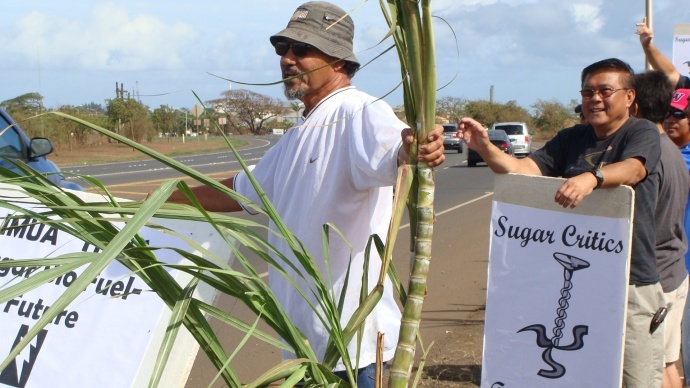
“If those people complain about burning cane–if they can support 800 workers–then they have a right to speak; but my point is who are they to say how to run the lifestyle of the island,” said Charles Jennings, HC&S retiree (front left) during a demonstration backing HC&S’s lifestyle and jobs in Sept. 2012. File photo by Wendy Osher.
Volner continued saying HC&S has and continues to evaluate a range of diversified agriculture uses for the land and other uses for the sugarcane plant. “Currently, HC&S is testing 100,000 varieties of cane and a dozen varieties of grass, as well as considering over a dozen crops as alternatives to sugar cane. We have established trial plots of a number of the crops researched—those with the greatest potential of sustaining the heavy winds of the Central Maui isthmus and the tropical climate/pests in Hawaiʻi, and the ability to be mass-produced for renewable energy feedstock or to meet consumer demand.”
He also states that the company has extensively evaluated biofuels, but says the technology advancements necessary to viably convert plant materials into energy on a production scale “haven’t been realized yet.”
“At present, there are no commercially viable conversion technologies that have been developed anywhere in the world. For now, our ability to burn remains an important factor in the survival of HC&S and the 750 jobs and other benefits it provides to Maui residents. However, we continue our evaluation of other sugar by-products and biofuel options, while awaiting technology breakthroughs,” said Volner.
Volner said that HC&S provides over $50 million in wages and benefits annually to its 750 employees, over $50 million in purchases to local vendors for services and supplies, and $9 million in taxes to state and county governments. “HC&S and our employees also provide contributions of money and time to support community organizations and non-profits. We are hopeful that we can remain a contributing member of this community for many more years to come.”



